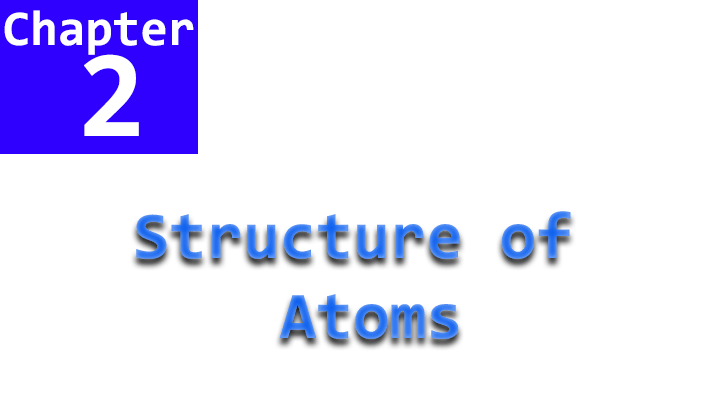9th Class Chemistry Chapter No. 2 Structure of Atom
Notes on The Structure of Atoms
Democritus and the Concept of Atoms
- Ancient Greek philosopher Democritus proposed that matter is composed of tiny indivisible particles called atoms. The term “atom” is derived from the Latin word “Atomos,” meaning indivisible.
- In the 19th century, John Dalton’s Atomic Theory stated that all matter is made up of very small indivisible particles called atoms.
Long Questions Answer Notes
Subatomic Particles
- In the early 20th century, experiments by Goldstein, J.J. Thomson, Rutherford, Bohr, and other scientists revealed that atoms are made up of subatomic particles.
- These subatomic particles include electrons, protons, and neutrons.
Short Questions Answer Notes
Thomson’s Plum Pudding Model
- Based on the discovery of electrons and protons, J.J. Thomson proposed the “plum pudding” model of the atom.
- In this model, atoms were considered as solid structures of positively charged matter with tiny negatively charged particles (electrons) embedded in them, resembling plums in a pudding.
Discovery of Electrons
- Sir William Crookes conducted experiments with cathode rays, which were shiny rays emitted from the cathode (negative electrode) in a discharge tube.
- Cathode rays were found to be negatively charged particles (electrons) that travel in straight lines and are deflected by electric and magnetic fields.
MCQ’s Notes
Discovery of Protons
Goldstein observed positively charged particles called “canal rays” in addition to cathode rays in a discharge tube with a perforated cathode. Canal rays were found to travel in the opposite direction to cathode rays and were positively charged. They were identified as protons, and their properties depended on the gas present in the discharge tube.
In summary, the study of subatomic particles revolutionized the understanding of the structure of atoms. Atoms were no longer considered indivisible but were found to be composed of electrons, protons, and neutrons. These discoveries paved the way for further advancements in atomic theory and quantum mechanics, leading to a deeper understanding of the fundamental nature of matter.
The Discovery of Neutron
Rutherford’s Observation and Prediction
In the early 1920s, Ernest Rutherford noticed that the atomic masses of elements could not be explained solely by the masses of electrons and protons in an atom. Rutherford predicted that there must be a neutral particle with a mass similar to that of a proton present in the atom.
Discovery of the Neutron
In 1932, James Chadwick discovered the neutron while conducting experiments where he bombarded alpha particles on a beryllium target. As a result of this experiment, highly penetrating radiations were produced, which were identified as neutrons.
Properties of Neutron
- Neutrons are neutral particles, carrying no charge.
- They are highly penetrating, able to pass through matter with ease.
- The mass of neutrons is nearly equal to the mass of protons.
After the discovery of the neutron, the structure of atoms became clearer, consisting of a nucleus (composed of protons and neutrons) surrounded by electrons. This led to further developments in atomic theory and provided a more comprehensive understanding of the composition and behavior of atoms.
The notes also cover Rutherford’s atomic model, which disproved the “plum-pudding” model and led to the understanding of the atom’s central nucleus. It also discusses Bohr’s atomic theory, which introduced the concept of quantized energy levels and orbits for electrons. The key postulates of Bohr’s model are explained, which revolutionized the understanding of atomic structure.
The study of atomic structure and subatomic particles has been a significant milestone in the field of physics and has paved the way for various scientific advancements and technological applications.
Electronic Configuration
Shells and Subshells
- Electrons revolve around the nucleus in energy levels called shells.
- Energy levels are represented by ‘n’ values: 1, 2, 3, and so on.
- Shells are designated by the alphabets K, L, M, and so on.
- K shell is the closest to the nucleus and has the lowest energy.
Quantum Theory
- Quantum theory deals with fixed energy levels or quanta.
- The concept of potential energy of an electron is discussed in higher classes.
- Max Planck’s work on the quantum theory earned him the Nobel Prize in Physics in 1918.
Rutherford’s Atomic Theory
- Based on classical theory, electrons revolve around the nucleus.
- No idea about orbits was introduced, and atoms were expected to produce continuous spectra.
- According to this theory, atoms should collapse.
Bohr’s Atomic Theory
- Based on quantum theory, electrons revolve in fixed energy orbits.
- Orbits had angular momentum.
- Atoms were expected to produce line spectra, and they were stable and should exist.
Electronic Configuration
- The distribution of electrons in different shells and subshells of an atom.
- Subshells are filled in the order: 1s, 2s, 2p, 3s, 3p, and so on.
- Maximum capacity of subshells: ‘s’ subshell can accommodate 2 electrons, ‘p’ subshell can accommodate 6 electrons.
Isotopes
- Isotopes are atoms of the same element with the same atomic number but different mass numbers.
- They have the same electronic configuration but different numbers of neutrons.
- Isotopes have similar chemical properties but different physical properties due to their varying mass numbers.
Uses of Isotopes
Radiotherapy: Isotopes are used for the treatment of cancer.
Tracers in Medicine: Radioactive isotopes are used for diagnostic purposes.
Archaeological and Geological Uses: Radioactive isotopes are used for age determination of fossils and rocks.
Chemical Reaction and Structure Determination: Radioisotopes are used to study chemical reactions and determine structures.
Applications in Power Generation: Nuclear reactors use isotopes to generate electricity.
Change in Scientific Theories
- Science is a process of producing knowledge through observation and theory invention.
- Theories are tested and improved or discarded based on new observations.
- Science aims for increasingly accurate approximations to explain how the world works.

